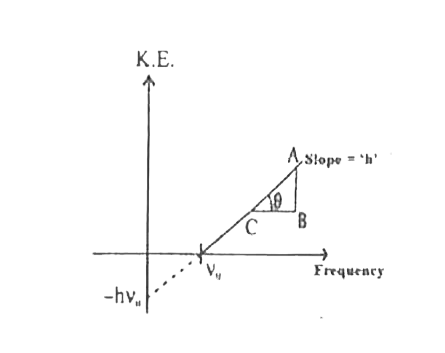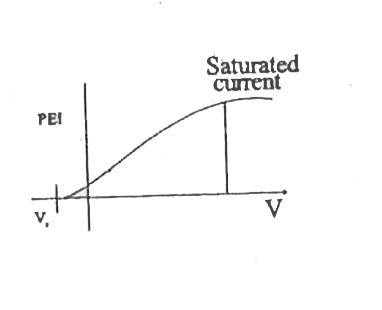Give Einstein's explanation of photoelectric effect. Solution in Kannada
Einstein assumed that one photoelectron is liberated from a metal surface when one photon of suitable frequency is incident on it. Consider a photon of frequency v and energy hv incident on a photo sensitive metal. The energy of photon is spent in liberating electrons.
(i) Since the collision between an electron and a photon is treated as the collision between two particles, the process is instantaneous.
(ii) If E=hv represents the incident photon energy and .w. is the minimum energy required to just liberate the electron from the surface and K.E. is the kinetic energy of electron then
E=w+K.E.
or hv=hv0+K.E.→(1) This is known as the P.E. equation.
For K.E.=0,hv=hv0=w. Therefore for every metal surface there exists minimum energy of the electron above which electron is liberated. The corresponding frequency is called the threshold frequency and the minimum energy corresponding to v is known as the work function.
(iii) K.E. =12mv2
12mv2=hv−hv0
112mv2=h(v−v0)

∴ K.E. and hence velocity of photoelectron depends on the frequency of incident radiation above the threshold frequency (v0) but not on the intensity of incident radiation.
(iv) For a particular negative potential of the anode, photoelectrons do not reach the anode. Hence P.E. current =0. This -ve potential of the anode for which PEI=0 is known as stopping potential.

(v) For v<v0,12mv2=−ve
which is absurd
∴ P.E.E. cannot take place for a frequency less than the threshold frequency.
(vi) Photo electrons will be ejected in large numbers when intense radiation is incident because intense radiation contains more photons resulting in more interactions.
Topper's Solved these Questions
- DUAL NATURE OF RADIATION AND MATTERBook:SUBHASH PUBLICATIONChapter:DUAL NATURE OF RADIATION AND MATTERExercise:NUMERICALS WITH SOLUTIONS
Explore 21 Videos
- DUAL NATURE OF RADIATION AND MATTERBook:SUBHASH PUBLICATIONChapter:DUAL NATURE OF RADIATION AND MATTERExercise:THREE MARK QUESTIONS WITH ANSWERS
Explore 5 Videos
- CURRENT ELECTRICITYBook:SUBHASH PUBLICATIONChapter:CURRENT ELECTRICITYExercise:NUMERICAL PROBLEMS AND ANSWERS
Explore 29 Videos
- ELECTRIC CHARGES AND FIELDSBook:SUBHASH PUBLICATIONChapter:ELECTRIC CHARGES AND FIELDSExercise:NUMERICALS WITH SOLUTIONS
Explore 21 Videos
Similar Questions
A photo has a wavelength of 5000 Å. Calculate its momentum.
View SolutionMention any three properties of a photon.
View SolutionIn the given circuit, calculate the effective resistance between A and B.

View SolutionTwo point charges −2nC and +8nC are separated in air by a distance of 0.10m.Find the position of the neutral point along the line joining the 2 point charges.
View SolutionEINSTEIN'S PHOTOELECTRIC EFFECT
View SolutionEinstein's work on photoelectric effect gives support to
View SolutionAlbert Einstein's explanation of the photoelectric effect confirmed which of the following concepts?
View Solutionप्रकाश विद्युत प्रभाव क्या है? आइंस्टीन के प्रकाश विद्युत समीकरण के आधार पर प्रकाश - विद्युत प्रभाव की व्याख्या कीजिए ।
View SolutionEinstein's work on photoelectric effect gives support to
View SolutionObtain Einstein's photoelectric equation with necessary explanation.
View SolutionExplain experimentally observed facts of photoelectric effect with the help of Einstein's explanation.
View SolutionEinstein's work on photoelectric effect gives support to
View SolutionObtain Einstein's photoelectric equation with necessary explanation.
View SolutionExplain experimentally observed facts of photoelectric effect with the help of Einstein's explanation.
View SolutionObtain Einstein's photoelectric equation with necessary explanation.
View Solution

